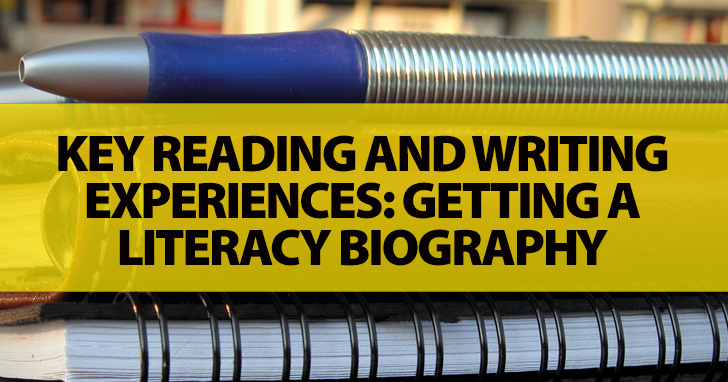Apply These Ideas for Literacy Biography Writing
-
1
What
What is a literacy biography? It is, like most biographies, a chronological discussion of the author’s life, or some aspect of it: in this case, focused on key literacy experiences of teachers, classes, and books that made an impression and impact on the writer. Often reading and writing experiences radically change us in some way that we haven’t even consciously considered.
For example, one student in a development composition class discussed the impact on his life of Alice Walker’s “The Color Purple,” the story a young African American woman’s struggle with and ultimate triumph over oppression in the segregated South, told through her letters and diary. The young man who was so moved by the story was drawn to it because it was the first story he had read written in the narrator’s authentic “voice,” with all of its idiosyncrasies, grammatical incorrectness, and beauty, growing in expressiveness as the character matures. This narrative structure awoke the student to the true possibilities of fiction and literacy itself--the variety of forms that may be legitimately called “literature.” Similarly, drawing from my own experience, I am not the same person I was for having read “The Great Gatsby” and “Breakfast at Tiffany’s” at age fifteen, these novels’ view of New York and its endless variety, possibility, and danger forever altering my perspective on that city and somehow life itself. In discussing these key literacy experiences, students can then begin to see the real impact reading and writing have had on their lives and therefore the importance of continuing to expand their literacy experiences.
Besides getting students to reflect on their reading and writing experiences, the literacy biography also gives the instructor insight into their students’ past experiences with reading and writing. This information then will help the teacher in determining what instructional methods and which curricula might be most valuable in the classroom. Just knowing that some students carry a preconceived notion that “good writing” is limited to handwriting and spelling skills, for example, can clue the teacher into that a beginning discussion is called for on the topic of what goes into “good writing.” In addition, reports from a number of students on their negative past experiences with literacy instruction--not uncommon-- can also inform the instructor this might be a class that will need some self-esteem building related to their writing skills, opportunities to experience success, and an environment free of public judgment of their skills that will allow growth.
-
2
Who
Developmental students and beginning composition students often benefit most from the assignment. Again, these students are many times carrying negative beliefs about literacy and learning and themselves as readers and writers because of unhelpful early experiences. For example, one young man in my developmental composition class, one of the most articulate and thoughtful students of that class, saw himself as a poor writer--a belief that seemed to have sprung from early experiences he related regarding his “bad handwriting” and being criticized for it. In writing about these experiences, the students can then begin questioning these beliefs (e.g., how related handwriting really is to actual composition skill and what we generally call “writing”). Once questioned, these existing negative understandings of themselves as writers can possibly be discredited enough to form a new writer’s “identity” that will allow growth.
-
3
How
So you have decided on the value of the literacy biography. How then do you actually implement the assignment?
On the first or second day of class, give out the prompt, or topic, to write a literacy biography. The assignment will probably need to be explained in detail, as students in all likelihood have never consciously considered key experiences in reading and writing and their effects. I offer ample examples of books and teachers that have influenced me and how. I also discuss methods to organize and format the assignment. One method of organization, for example, is first discussing books, teachers, and classes that influenced them as readers and writers and then reflecting on why these experiences were so formative. After students have written for about a half hour, they can begin to share their experiences in groups and usually find areas of commonality: a shared love for a specific author, for example, or common experiences with the kind of writing classes and teachers they have had, both positive and negative.
-
4
Why
To summarize, one major use of the literacy biography is to get students to begin to reflect on their key literacy experiences. They can then either reaffirm or begin to question those experiences as related to those preexisting ideas of their literacy skills rather than just accepting they are by birth “not good writers” or “naturally” bad readers. In addition, the literacy biography gives the teacher insight into her students’ reading and writing background to inform her teaching.
Finally, through sharing their literacy experiences, students find areas of commonality and begin to form a writing community, a safe space to express ideas.
A literacy biography is not a standard writing assignment and may at first blush seem confusing or unimportant to students, a “throwaway” assignment to fill time the first days of class while the dust settles during the add/drop period and everyone gets used to the class routine. However, implemented correctly, a literacy biography is not fluff but rather a key assignment opening the door to student reflection, teacher information, and the creation of a safe environment for developing reading and writing skills.
What are your thoughts on the value and implementation of a literacy biography?
P.S. If you enjoyed this article, please help spread it by clicking one of those sharing buttons below. And if you are interested in more, you should follow our Facebook page where we share more about creative, non-boring ways to teach English.








